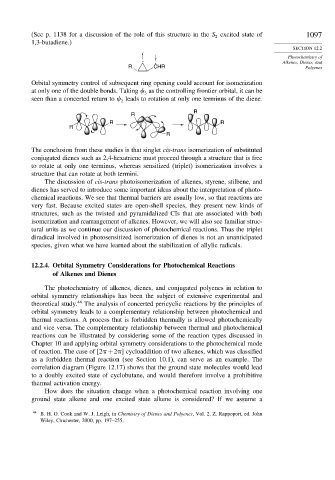Page 1112 - Advanced Organic Chemistry Part A - Structure and Mechanisms, 5th ed (2007) - Carey _ Sundberg
P. 1112
(See p. 1138 for a discussion of the role of this structure in the S excited state of 1097
2
1,3-butadiene.)
SECTION 12.2
Photochemistry of
. . Alkenes, Dienes, and
R CHR Polyenes
Orbital symmetry control of subsequent ring opening could account for isomerization
at only one of the double bonds. Taking as the controlling frontier orbital, it can be
3
seen than a concerted return to leads to rotation at only one terminus of the diene.
2
R
R
R R
R
R
The conclusion from these studies is that singlet cis-trans isomerization of substituted
conjugated dienes such as 2,4-hexatriene must proceed through a structure that is free
to rotate at only one terminus, whereas sensitized (triplet) isomerization involves a
structure that can rotate at both termini.
The discussion of cis-trans photoisomerization of alkenes, styrene, stilbene, and
dienes has served to introduce some important ideas about the interpretation of photo-
chemical reactions. We see that thermal barriers are usually low, so that reactions are
very fast. Because excited states are open-shell species, they present new kinds of
structures, such as the twisted and pyramidalized CIs that are associated with both
isomerization and rearrangement of alkenes. However, we will also see familiar struc-
tural units as we continue our discussion of photochemical reactions. Thus the triplet
diradical involved in photosensitized isomerization of dienes is not an unanticipated
species, given what we have learned about the stabilization of allylic radicals.
12.2.4. Orbital Symmetry Considerations for Photochemical Reactions
of Alkenes and Dienes
The photochemistry of alkenes, dienes, and conjugated polyenes in relation to
orbital symmetry relationships has been the subject of extensive experimental and
theoretical study. 44 The analysis of concerted pericyclic reactions by the principles of
orbital symmetry leads to a complementary relationship between photochemical and
thermal reactions. A process that is forbidden thermally is allowed photochemically
and vice versa. The complementary relationship between thermal and photochemical
reactions can be illustrated by considering some of the reaction types discussed in
Chapter 10 and applying orbital symmetry considerations to the photochemical mode
of reaction. The case of [2 +2 ] cycloaddition of two alkenes, which was classified
as a forbidden thermal reaction (see Section 10.1), can serve as an example. The
correlation diagram (Figure 12.17) shows that the ground state molecules would lead
to a doubly excited state of cyclobutane, and would therefore involve a prohibitive
thermal activation energy.
How does the situation change when a photochemical reaction involving one
ground state alkene and one excited state alkene is considered? If we assume a
44
B. H. O. Cook and W. J. Leigh, in Chemistry of Dienes and Polyenes, Vol. 2, Z. Rappoport, ed. John
Wiley, Chichester, 2000, pp. 197–255.

